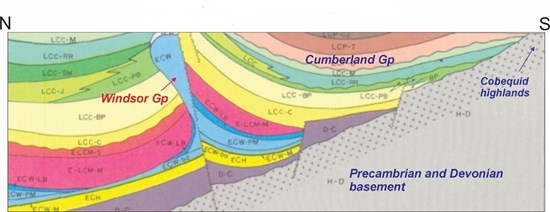QIMC Confirms Fourth Major Natural Hydrogen Zone in Nova Scotia with Soil-Gas Results up to 4,850 ppm - 2 km Continuous Anomaly Along Windsor-Cumberland Fault
Quebec Innovative Materials Corp. (OTCQB: QIMCF) has announced the discovery of its fourth major natural hydrogen zone in Nova Scotia, featuring exceptional soil-gas concentrations up to 4,850 ppm along a 2 km continuous anomaly in the Little Forks-Springhill area.
The exploration program yielded impressive results with over 24 readings above 500 ppm, including four results between 1,500-1,999 ppm and two between 2,000-2,999 ppm. This discovery establishes two principal hydrogen corridors on both sides of the Cumberland Basin, potentially supporting the development of a clean ammonia production hub.
The site's geology features the Ragged Reef sandstones as reservoir potential, Windsor Group evaporites as barriers, and favorable geothermal conditions driving hydrogen migration. The company plans to continue development with teams returning to Nova Scotia on October 5, 2025.
Quebec Innovative Materials Corp. (OTCQB: QIMCF) ha annunciato la scoperta della sua quarta grande zona naturale di idrogeno in Nuova Scotia, con eccezionali concentrazioni di gas nel suolo fino a 4.850 ppm lungo un’anomalia continua di 2 km nell’area Little Forks-Springhill.
Il programma di esplorazione ha prodotto risultati notevoli con più di 24 letture superiori a 500 ppm, tra cui quattro letture tra 1.500-1.999 ppm e due tra 2.000-2.999 ppm. Questa scoperta stabilisce due principali corridoi di idrogeno ai lati della Cumberland Basin, potenzialmente in grado di sostenere lo sviluppo di un polo di produzione di ammoniaca pulita.
La geologia del sito comprende le arenarie Ragged Reef come potenziale serbatoio, gli evaporiti del Windsor Group come barriere e condizioni geotermiche favorevoli che guidano la migrazione dell’idrogeno. L’azienda intende proseguire lo sviluppo con i team che rientreranno in Nuova Scozia il 5 ottobre 2025.
Quebec Innovative Materials Corp. (OTCQB: QIMCF) ha anunciado el descubrimiento de su cuarta gran zona natural de hidrógeno en Nueva Escocia, con excepcionales concentraciones de gas en el suelo de hasta 4,850 ppm a lo largo de una anomalía continua de 2 km en el área Little Forks-Springhill.
El programa de exploración arrojó resultados impresionantes con más de 24 lecturas por encima de 500 ppm, incluyendo cuatro lecturas entre 1.500-1.999 ppm y dos entre 2.000-2.999 ppm. Este descubrimiento establece dos corredores principales de hidrógeno a ambos lados de Cumberland Basin, potencialmente capaces de apoyar el desarrollo de un hub de producción de amoníaco limpio.
La geología del sitio presenta las areniscas Ragged Reef como posible reservorio, los evaporitos del Windsor Group como barreras y condiciones geotérmicas favorables que impulsan la migración del hidrógeno. La empresa planea continuar el desarrollo con los equipos que regresarán a Nueva Escocia el 5 de octubre de 2025.
Quebec Innovative Materials Corp. (OTCQB: QIMCF)가 뉴 스코샤의 네 번째 주요 천연 수소 지역을 발견했다고 발표했습니다. Little Forks-Springhill 지역의 길이 2km에 걸친 연속 이상에서 토양-가스 농도 최대 4,850 ppm을 보였습니다.
탐사 프로그램은 500 ppm 이상 24회 이상 측정을 비롯해 1,500-1,999 ppm 사이의 네 번, 2,000-2,999 ppm 사이의 두 번의 결과를 포함하는 인상적인 결과를 냈습니다. 이 발견은 Cumberland Basin 양측에 두 개의 주요 수소 교차로를 확립하여 청정 암모니아 생산 허브 개발을 뒷받침할 가능성을 시사합니다.
현장의 지질은 저장소 후보로 Ragged Reef 사질암층, 장애물로 Windsor Group 훈층염광, 수소 이동을 이끄는 유리한 지열 조건을 특징으로 합니다. 회사는 2025년 10월 5일에 뉴 스코샤로 재돌입하는 팀과 함께 개발을 계속할 계획입니다.
Quebec Innovative Materials Corp. (OTCQB: QIMCF) a annoncé la découverte de sa quatrième grande zone naturelle d’hydrogène en Nouvelle-Écosse, avec des concentrations exceptionnelles de gaz dans le sol atteignant 4 850 ppm le long d’une anomalie continue de 2 km dans la zone Little Forks-Springhill.
Le programme d’exploration a donné des résultats impressionnants avec plus de 24 relevés au-dessus de 500 ppm, dont quatre entre 1 500 et 1 999 ppm et deux entre 2 000 et 2 999 ppm. Cette découverte établit deux couloirs principaux d’hydrogène de part et d’autre de Cumberland Basin, susceptibles de soutenir le développement d’un hub de production d’ammoniac propre.
La géologie du site présente les grès de Ragged Reef comme potentiel réservoir, les évaporites du Windsor Group comme barrières et des conditions géothermiques favorables favorisant la migration de l’hydrogène. L’entreprise prévoit de poursuivre le développement avec des équipes revenant en Nouvelle-Écosse le 5 octobre 2025.
Quebec Innovative Materials Corp. (OTCQB: QIMCF) hat die Entdeckung seiner vierten großen natürlichen Wasserstoffzone in Nova Scotia bekannt gegeben, mit außergewöhnlichen Boden-Gas-Konzentrationen bis zu 4.850 ppm entlang einer 2 km langen, durchgehenden Anomalie im Gebiet Little Forks-Springhill.
Das Explorationsprogramm lieferte beeindruckende Ergebnisse mit mehr als 24 Messungen über 500 ppm, darunter vier Messungen zwischen 1.500-1.999 ppm und zwei zwischen 2.000-2.999 ppm. Diese Entdeckung etabliert zwei Haupt-Wasserstoff-Korridore auf beiden Seiten des Cumberland Basin, die die Entwicklung eines sauberen Ammoniak-Produktionszentrums unterstützen könnten.
Die Geologie des Standorts umfasst Ragged Reef-Sandsteine als Reservoirpotenzial, Windsor Group-Evaporite als Barrieren und günstige Geothermiebedingungen, die die Wasserstoffmigration antreiben. Das Unternehmen plant, die Entwicklung fortzusetzen, mit Teams, die am 5. Oktober 2025 nach Nova Scotia zurückkehren.
Quebec Innovative Materials Corp. (OTCQB: QIMCF) أعلنت عن اكتشاف رابع منطقة طبيعية للهيدروجين في نوفا سكوتيا، مع تركيزات استثنائية من غاز التربة تصل إلى 4,850 جزء في المليون على امتداد شِـبْهٍ مستمر بطول 2 كم في منطقة Little Forks-Springhill.
نتائج برنامج الاستكشاف كانت مبهرة مع أكثر من 24 قراءة تفوق 500 جزء في المليون، بما في ذلك أربع قراءات بين 1,500-1,999 جزء في المليون واثنتان بين 2,000-2,999 جزء في المليون. هذه الاكتشاف يضع مسارين رئيسيين للهيدروجين على جانبي Cumberland Basin، قد يدعمان تطوير محور إنتاج أمونيا نظيفة.
جيولوجيا الموقع تتضمن رمل Ragged Reef كاحتمال خزّان، و evaporites Windsor Group كعوائق، وظروف جيودوحرارية مواتية تدفع هجرة الهيدروجين. تخطط الشركة لاستمرار التطوير مع فرق ستعود إلى نوفا سكوتيا في 5 أكتوبر 2025.
Quebec Innovative Materials Corp. (OTCQB: QIMCF) 已宣布在新斯科舍省发现其的
勘探计划取得了令人印象的结果,超过24次读数高于500 ppm,其中4次在1,500-1,999 ppm之间,2次在2,000-2,999 ppm之间。这一发现在 Cumberland Basin 的两侧确立了两个主要的氢通道,可能支持清洁氨给生产枢纽的发展。
该地点的地质特征包括 Ragged Reef 砂岩作为储层潜力,Windsor Group 蒸发岩作为屏障,以及有利的地热条件推动氢的迁移。公司计划继续开发,团队将于 2025年10月5日 返回新斯科舍省。
- Discovery of fourth major natural hydrogen zone with exceptional concentration up to 4,850 ppm
- Confirmation of 2 km continuous hydrogen expression along strategic fault line
- Identification of two principal hydrogen corridors supporting potential clean ammonia production hub
- Favorable geological conditions including natural reservoirs and barriers for hydrogen storage
- Complex geology affected by numerous faults requiring careful development strategy
- Early-stage exploration results requiring further validation and development work
Montreal, Quebec--(Newsfile Corp. - October 1, 2025) - Quebec Innovative Materials Corp. (CSE: QIMC) (OTCQB: QIMCF) (FSE: 7FJ) ("QIMC" or the "Company") is pleased to announce the confirmation of a fourth major natural hydrogen zone in Nova Scotia, highlighted by a peak soil-gas concentration of 4,850 ppm. The newly identified zone, located in the Little Forks-Springhill area, highlights a restricted geological context where source, reservoir, and barrier conditions combine to create a 2 km continuous expression of hydrogen along the boundary fault separating the Windsor Group from the Cumberland Group.
The analytical program returned over 24 readings above 500 ppm, four results between 1,500-1,999 ppm, two results between 2,000-2,999 ppm, and a high of 4,850 ppm — confirming the exceptional strength and extent of this anomaly.
This breakthrough further demonstrates the remarkable scale of hydrogen anomalies in Nova Scotia, adding to QIMC's three previously announced discoveries. With the identification of two principal hydrogen corridors on both sides of the Cumberland Basin, one in the East and one in the West of the province, separated by only a 1 hour 15 drive, this further demonstrates the regional scale necessary to support the development of a clean ammonia production hub.
"This fourth discovery validates our exploration thesis: Nova Scotia possesses the right geological conditions faulted and folded reservoirs, sealed by impermeable evaporites that can host large-scale natural hydrogen accumulations," said John Karagiannidis, President & CEO of QIMC. "With hydrogen zones confirmed on both sides of the Cumberland corridor, we are looking at the foundations of a regional development model, including ammonia production, built on multiple high-potential corridors."
The QIMC and INRS teams will be returning to Nova Scotia on October 5, 2025, to begin the next phases of development.
LITTLE FORKS-SPRINGHILL AREA CONTEXT
The exploration site, centered on the Little Forks-Springhill area, is located approximately 20 km NE of the Southampton area. The natural resources of the Springhill area are nationally recognized for its coal mines that have been in operation since the 19th century and for the use of the geothermal resource present in the vicinity of the old coal mines.
Overall, the Little-Forks-Springhill area shows topographic undulations reflecting a complex geology affected, among other things, by numerous NE-SW and E-W faults intersecting the carbonaceous rocks of the Cumberland Basin. The objective of the exploration program in the Little Fork-Springhill area was to evaluate the hydrogen potential of the western end of the Athol syncline (Fig. 1) and more specifically in a region affected by salt tectonics (saline diapirism) related to the emplacement of salt and anhydrite-gypsum domes of the Windsor Group (Fig. 2). This geological context, different from that of Southampton, is characterized by a verticalization of structures that could facilitate, among other things, the ascent of hydrogen from deep and hot sources due to a particularly high geothermal gradient in this part of Nova Scotia. The presence of evaporites within the Windsor Group is an important feature of the local geology and, in a potential hydrogen production context, these rocks could be used for hydrogen storage.
"The Ragged Reef sandstones provide excellent reservoir potential, the Windsor Group evaporites act as barriers, and the local geothermal gradient provides the driving energy for hydrogen migration," notes Prof. Marc Richer-Laflèche, INRS.
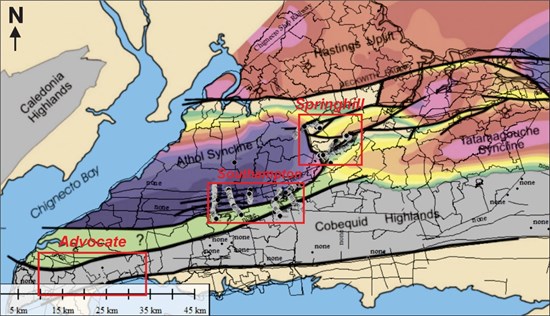
Figure 1. Simplified geological map showing the basement upwellings of the Cobequid and Hastings Highlands and the major synclines of the Cumberland region of Nova Scotia. Modified from Durling (2023).
To view an enhanced version of this graphic, please visit:
https://images.newsfilecorp.com/files/7968/268627_21131fad9481da5a_001full.jpg
Geological Context
The geology of the Springhill area is complex because it is affected by salt tectonics related to the emplacement of diapirs of salt, anhydrite (and gypsum) formations rising through the carbonaceous sedimentary rocks of the Cumberland Group (Fig.2). This particular geology is accompanied by faults, deeper-dipping geological contacts, horst-like rock uplifts and folds. These structures can create traps and/or potential migration pathways for hydrogen.
Figure 2. Schematic geological section showing the influence of the placement of a Windsor Gp salt diapir in the rocks of the Cumberland Group. Note the verticalization of the structures in the vicinity of the diapir. Modified figure from Ryan et al. (1990).
To view an enhanced version of this graphic, please visit:
https://images.newsfilecorp.com/files/7968/268627_21131fad9481da5a_002full.jpg
The geological map, highlighting the chaotic and discontinuous nature of the geology of the Springhill area, also shows the location of the sampling sites along the Little Fork and Salt Spring sections (sections 1 and 2) (Fig. 3). As for the Southampton exploration area, the highest concentrations of hydrogen in the soils are observed over the Carboniferous Ragged Reef Formation, which consists of alternating fluvial sandstones, conglomerates, mudstones, lake limestones and rare coal horizons. In the Cumberland Basin, the characteristics of the rocks in this geological formation appear to be highly favorable to the presence of hydrogen in the subsurface, especially when they are located near certain regional faults. On the other hand, the results of the measurements carried out over the salt, anhydrite and gypsum formations of the Windsor Gp (Fig. 3; Little Fork section) show very low soil-gas hydrogen concentrations of around 0 ppm, which confirms the very low permeability of the evaporite formations, which seem to constitute real barriers limiting the ascent of hydrogen. "In addition, it is important to note that evaporites are often associated with structural traps. Their density and rigidity can cause folding and faulting, creating potential traps for hydrogen," added Prof Richer-Laflèche.
Conceptually, it would be conceivable that reservoirs could form in the Ragged Reef Fm, as it contains coarse sandstone units (sublitharenite and subarkose sandstones) and conglomerates of high-energy river environments potentially favorable to the formation of quality reservoirs. These units are locally covered by shales and siltstones that can form relatively impermeable membranes.
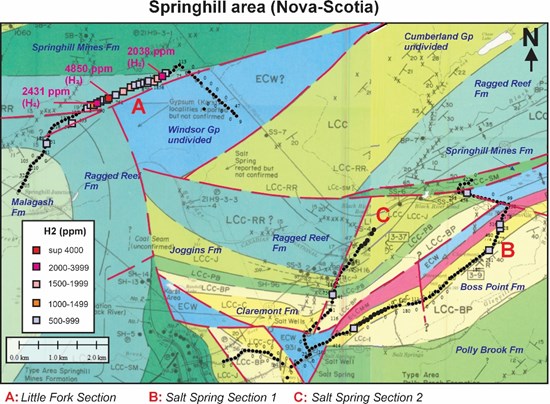
Figure 3. Geological map of the Little Fork-Springhill area and location of geochemical surveys of hydrogen in soils. Modified map from Ryan et al. (1990).
To view an enhanced version of this graphic, please visit:
https://images.newsfilecorp.com/files/7968/268627_21131fad9481da5a_003full.jpg
ANALYTICAL RESULTS FROM THE SOIL-GAS SURVEYS IN THE SPRINGHILL AREA
The work was carried out from 8 to 9 August 2025 under sunny weather conditions (average temperature of 30.7 °C, average atmospheric pressure of 1011.7 HPa and average relative humidity of 33.7 %). A total of 208 samples were collected from 3 sections totalizing 19.9 km along public roads of the Springhill area.
The mean and median hydrogen concentrations measured in the soils of this sector are particularly variable. Minimum, maximum and average concentrations are presented in table 1. The sections of the Soil-Gas surveys are presented in Figure 4 and the spatial distribution map of the hydrogen anomalies is presented in Figure 3.
Table 1: H2 soil-gas geochemistry in Little Forks-Springhill area public roads
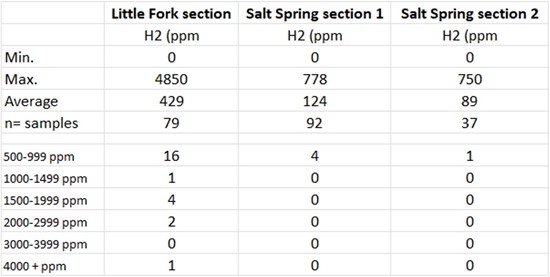
To view an enhanced version of this graphic, please visit:
https://images.newsfilecorp.com/files/7968/268627_qimc%20table%201.jpg
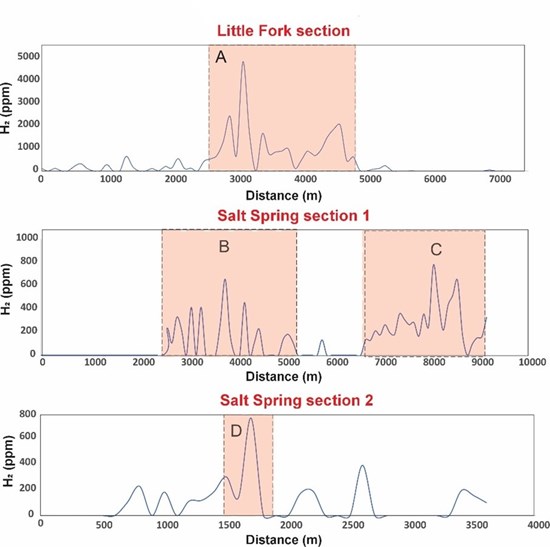
Figure 4. Sections showing the variability of soil hydrogen concentrations along the Little Fork and Salt Springs sections 1 and 2 of the Springhill area.
To view an enhanced version of this graphic, please visit:
https://images.newsfilecorp.com/files/7968/268627_21131fad9481da5a_005full.jpg
About Pr. Marc Richer-LaFlèche, P.Geo.
Pr. Richer-Laflèche, a qualified expert in hydrogen exploration, has reviewed, read and approved the technical content presented in this press release. Pr. Richer-Laflèche confirms that the methodologies employed, data presented, and interpretations made conform to current industry practices and standards relating to hydrogen exploration.
About QIMC
Quebec Innovative Materials Corp. is a mineral exploration and development company dedicated to exploring and harnessing the potential of North America's abundant resources. With properties in Ontario, Quebec, Nova Scotia and Minnesota (US), QIMC is focused on specializing in the exploration of white (natural) hydrogen and high-grade silica deposits. QIMC is committed to sustainable practices and innovation. With a focus on environmental stewardship and cutting-edge extraction technology, we aim to unlock the full potential of these materials to drive forward clean energy solutions to power the AI and carbon-neutral economy and contribute to a more sustainable future.
QUÉBEC INNOVATIVE MATERIALS CORP.
John Karagiannidis
Chief Executive Officer
For further information, please contact:
Email: info@qimaterials.com
Tel: +1 514-726-7058
REFERENCES
- Durling, P. 2023. Seismic-reflection interpretation of the carboniferous Cumberland Basin, northern Nova Scotia. Geological Survey of Canada Open File 2816-7155; 8937. 64 pages.
- Ryan, R.J, Boehner, R.C. and Deal, A., 1990. Maps ME 1990-012 and ME 1990-013: Cumberland Basin Geology Map. Cumberland County. Government of Nova Scotia, Department of Natural Resources and Renewables.
Neither the Canadian Securities Exchange nor its Regulation Services Provider (as that term is defined in the CSE policies) accepts responsibility for the adequacy or accuracy of this news release and has neither approved nor disapproved the contents of this news release.
Forward-Looking Statements
This news release contains statements that constitute "forward-looking statements". Such forward-looking statements involve known and unknown risks, uncertainties and other factors that may cause Québec Innovative Materials' actual results, performance or achievements, or developments in the industry to differ materially from the anticipated results, performance or achievements expressed or implied by such forward-looking statements. Forward-looking statements are statements that are not historical facts and are generally, but not always, identified by the words "expects," "plans," "anticipates," "believes," "intends," "estimates," "projects," "potential" and similar expressions, or that events or conditions "will," "would," "may," "could" or "should" occur.
Although Québec Innovative Materials believes the forward-looking information contained in this news release is reasonable based on information available on the date hereof, by their nature, forward-looking statements involve assumptions, known and unknown risks, uncertainties and other factors which may cause our actual results, performance or achievements, or other future events, to be materially different from any future results, performance or achievements expressed or implied by such forward-looking statements.
Examples of such assumptions, risks and uncertainties include, without limitation, assumptions, risks and uncertainties associated with general economic conditions in Canada and abroad; adverse industry events; future legislative and regulatory developments in the natural resources sector, in particular as regards the regulation of white (natural) hydrogen exploration, development and exploitation; the Company's ability to access sufficient capital from internal and external sources, and/or inability to access sufficient capital on favorable terms; natural resources industry and markets in Canada and generally; the ability of Québec Innovative Materials to implement its business strategies; competition; and other assumptions, risks and uncertainties.
The forward-looking information contained in this news release represents the expectations of the Company as of the date of this news release and, accordingly, is subject to change after such date. Readers should not place undue importance on forward-looking information and should not rely upon this information as of any other date. While the Company may elect to, it does not undertake to update this information at any particular time except as required in accordance with applicable laws.
Cautionary Statements This news release contains "forward-looking information" and "forward-looking statements" within the meaning of applicable Canadian securities legislation. These statements are based on expectations, estimates, and projections as of the date of this release. Forward-looking statements involve risks and uncertainties, which may cause actual results to differ materially from current expectations. Readers are cautioned not to place undue reliance on these statements, as no assurance can be provided regarding future outcomes.
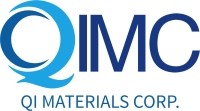
To view the source version of this press release, please visit https://www.newsfilecorp.com/release/268627








